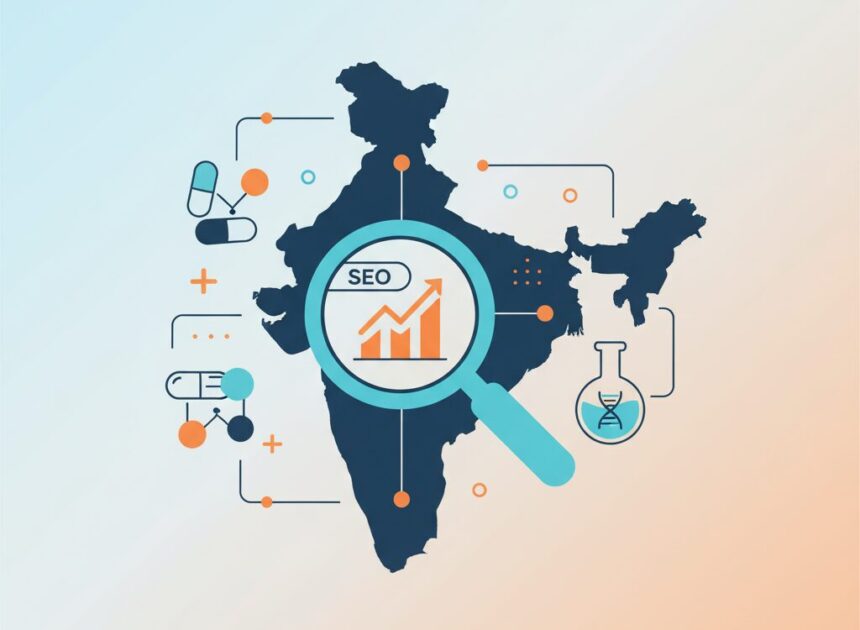For pharmaceutical companies in India, digital marketing operates on a knife-edge. On one side lies the immense opportunity to engage with Healthcare Professionals (HCPs), support medical research, and connect with distributors through digital channels. On the other hand lies a stringent and unforgiving regulatory landscape, governed by the Uniform Code for Pharmaceutical Marketing Practices (UCPMP) and the CDSCO, where a single non-compliant claim can lead to severe penalties and reputational damage.
This is the central, unavoidable challenge of Pharma SEO: how to achieve digital discoverability while operating with a zero-tolerance policy for compliance risk. A generic SEO strategy is not just ineffective here; it’s dangerous.
This guide provides a practical, compliance-aware framework for Indian pharma marketers, digital strategists, and medical affairs teams. We will explore how to structure product pages for discovery by HCPs, tag clinical papers to appear in relevant scientific searches, and support B2B outreach for distributor leads—all while embedding compliant copy, medical disclaimers, and a risk-averse methodology into the very core of your digital strategy.
Product Page Checklist for Compliant SEO
A pharmaceutical product page is fundamentally different from a standard commercial page. Its primary purpose is to convey factual, unbiased information to a qualified professional audience. Every word, image, and link must be precise, verifiable, and optimized within strict regulatory guardrails. Effective drug product page optimization is an exercise in accuracy.
Uphold Factual Language and Fair Balance
The bedrock of pharma compliance content is the complete avoidance of promotional language and unapproved claims. Your copy must be objective, directly supported by approved data, and meticulously balanced.
- No Unsubstantiated or Superiority Claims: Avoid any subjective or superlative language like “best,” “most effective,” “superior,” or “miracle.” Any claims of superiority over another product must be supported by substantial, publicly available head-to-head clinical trial data.
- Provide Verifiable References: Every single efficacy or safety claim must be accompanied by a clear citation and, where possible, a direct link to the peer-reviewed study, clinical trial data, or approved prescribing information (PI) that substantiates it.
- Maintain Fair Balance: It is a core regulatory requirement to present both the benefits and the risks of a product with equal prominence. The sections on side effects, contraindications, and warnings are just as crucial as the indications and usage section and must not be downplayed or hidden.
Demonstrate E-A-T (Expertise, Authoritativeness, Trustworthiness)
Google classifies all medical and pharmaceutical websites as “Your Money or Your Life” (YMYL) content. This means they are judged by the highest possible standards of quality, as outlined in Google’s Search Quality Rater Guidelines. Demonstrating E-A-T is therefore non-negotiable.
- Showcase Medical Expertise: All clinical content must be written, reviewed, and approved by qualified medical professionals. Implement author pages with biographies, credentials, and links to their professional profiles (e.g., LinkedIn, research portals). Consider creating a dedicated “Medical Advisory Board” or “Scientific Reviewers” page to showcase the expertise behind your content.
- Maintain Content Currency: Add a visible “Last Reviewed” or “Last Updated” date stamp on all clinical pages. This signals to both users and search engines that the information is current and trustworthy.
- Cite Authoritative Sources: Reinforce your content’s authority by linking out to highly reputable sources such as official medical journals (The Lancet, NEJM), government health bodies (ICMR, WHO), and official clinical trial registries.
Leverage Structured Data for Unambiguous Clarity
Schema markup is code that explicitly tells search engines what your content is about. For pharma, it’s a powerful tool for removing ambiguity and improving how your pages are represented in search results.
- Product Schema: Use this to specify the drug’s proprietaryName (brand name), nonProprietaryName (generic name), drugClass, dosage form, and manufacturer.
- Organization Schema: Clearly identify your company as a legitimate pharmaceutical organization, including your official name, logo, and corporate contact information.
- Document Schema: When linking to clinical papers, trial data, or prescribing information PDFs, wrapping the link in Document schema can help Google understand that it is a scientific or official document, aiding in medical papers indexing.
Make Your Clinical Research Discoverable
Pharmaceutical companies are powerhouses of valuable clinical data, but this content is often locked away in PDF files that are notoriously difficult for search engines to index and for users to find. A strategic approach to clinical research SEO can turn your research archive into a powerful asset for engaging the scientific community.
The Problem with a “PDF-Only” Strategy
Simply uploading a scientific paper as a PDF is a significant missed opportunity. PDFs are often inconsistently indexed by Google, lack navigational elements, are not mobile-friendly, and make it impossible to track user engagement beyond a simple download count.
The Gated HTML Landing Page Solution
The industry best practice is to create a dedicated HTML landing page for each significant clinical paper, study, or research asset. This page acts as an optimized “gateway” to the full document.
- Create an Optimized HTML Page: This page should be structured like a scientific abstract. It must include an optimized title tag (e.g., [Study Name]: A Phase 3 Clinical Trial Summary), a concise executive summary, key findings and endpoints presented in clear bullet points, and essential metadata like authors, publication date, and journal citation.
- Gate the Full PDF for Lead Capture: The full PDF document should be offered for download behind a simple, compliant form. This is an excellent, non-promotional way to capture qualified leads from interested HCPs, researchers, and potential partners.
- Use Canonical Links to Consolidate Authority: To prevent duplicate content issues, the HTML landing page must be designated as the “master” version. This is achieved by using a canonical link from the PDF’s HTTP header back to the landing page URL, ensuring all SEO authority is consolidated to the web page.
Optimizing for Google Scholar
To maximize visibility within the scientific community, ensure your research is discoverable on Google Scholar. This requires ensuring your web pages and PDFs meet certain technical criteria, including clear bibliographical data (title, authors, publication date) and ensuring the full text is easily crawlable. The HTML landing page approach supports this perfectly.
PPL Keywords & B2B Lead Capture
Beyond informing HCPs, SEO is a powerful engine for your B2B operations, from sourcing API suppliers to recruiting new distributors. The keyword strategy for this audience is far more direct and commercially focused.
Target High-Intent B2B Keywords
Your B2B audience—distributors, wholesalers, and manufacturing partners—uses highly specific, transactional search terms. Your Pay-Per-Lead (PPL) and organic strategy should target these queries:
- pharma distributor inquiry Mumbai
- API supplier India contact
- pharma product enquiry India
- third party pharma manufacturing quote
Content for the B2B Distributor Funnel
A potential distributor needs more than a contact form; they need to trust your operational excellence. Support your B2B landing pages with content that builds this confidence, such as:
- Detailed articles about your quality assurance and control processes.
- Information about your certifications (e.g., WHO-GMP, ISO).
- Case studies on your supply chain and cold chain logistics capabilities.
A sophisticated Pharma SEO strategy must be multifaceted, addressing the distinct needs of both clinical and commercial audiences. The intricate nature of this work is why many companies partner with specialized agencies. Our pharmaceutical SEO services are built from the ground up on a compliance-first foundation, ensuring your digital assets are both visible and safe. As technology progresses, understanding The Future of AI For SEO: Beyond the Hype will also become crucial for analyzing vast amounts of clinical data for discoverability while helping to flag potential compliance risks before they become a problem.
The Final Word: Compliance as a Strategic Advantage
In the Indian pharmaceutical industry, SEO is not about finding regulatory loopholes. It is about building a robust digital ecosystem of clear, factual, and helpful information that is easily and ethically discoverable by the right professional audience. By treating compliance not as a barrier, but as the guiding principle of your digital strategy, you can build a powerful, authoritative, and sustainable online presence that drives both HCP engagement and B2B growth.
Ready to make your clinical assets discoverable, safely?
Let us help you navigate the complexities of compliant pharmaceutical SEO.
Request a compliant product-page checklist and a discovery audit for your clinical assets.







